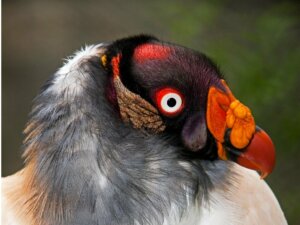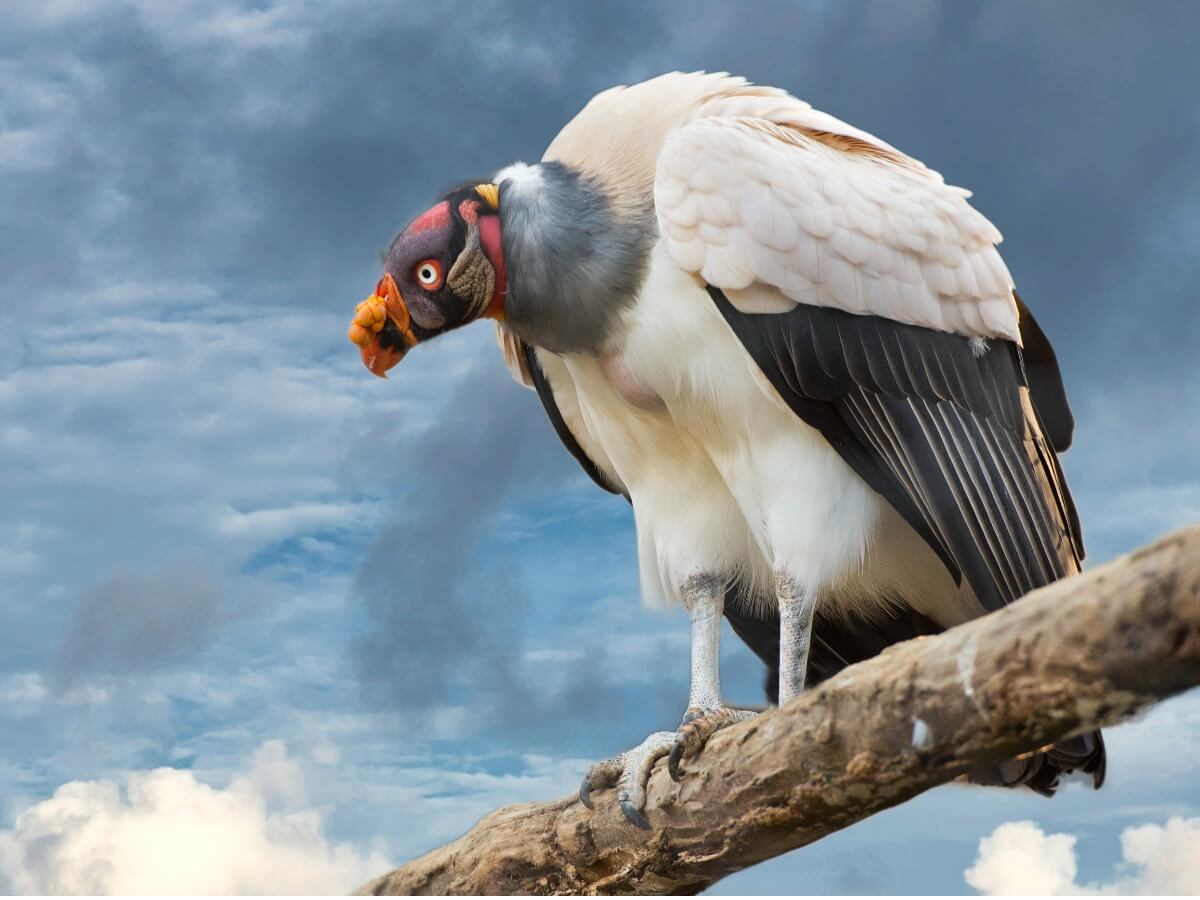King Vulture: Habitat and Characteristics


Written and verified by the biologist Raquel Rubio Sotos
The king vulture (Sarcoramphus papa) is one of the New World vultures, which includes 7 American species, and belongs to the Cathartidae family. Although it’s an iconic bird, we don’t know too much about its behavior.
This bird is distinguished from other vultures by its white plumage and beautiful head coloring. If you’d like to find out more about this beautiful species, we encourage you to continue reading.
Habitat of the king vulture
The king vulture is distributed throughout the American continent, from Mexico to northern Argentina. It usually lives in tropical lowland forests or, failing that, in savannas and grasslands near these forests.
They’re closely linked to watercourses, since, unlike other vultures, they need to drink a lot and they also use it to groom their feathers. For this reason, they’re always close to riverbeds or lakes. They carry out their activities in areas up to 1,200 meters (about 4000 feet) above sea level, and, although their exact habitat is unknown, experts believe that they use the treetops to rest.

Physical characteristics
The king vulture differs from the others by its spectacular coloring. It has a mostly white plumage (when it’s an adult), with black tips on its wings and tail. Mature specimens can reach a wingspan of up to 200 centimeters (6.5 feet) with open wings and a total length of 70 to 80 centimeters (2.3 to 2.6 feet).
The head has no feathers, which allows the plumage not to be stained with food remains, thus avoiding diseases. It also stands out for its bright coloring. This bird has caruncles and fleshy red and orange papillae around its beak. Its iris is white, with a red orbital ring.
Within the Cathartiformes group, it stands out for its beak, which is stronger than that of other vultures. Its legs are black, with not very developed claws. Juveniles have brown feathers and it’s in the sixth year when they acquire adult plumage.
Sexual dimorphism in this species is minimal, as males and females are practically indistinguishable.
Species behavior
Not much is known about the behavior of the king vulture in the wild. They’re known to be solitary animals and don’t congregate in large groups. On the other hand, they aren’t migratory birds and remain in the same territory throughout the year.
Adult specimens tend to spend most of their time unnoticed, high in the treetops or flying looking for food. Being large birds, they need air currents to glide and practically don’t move their wings while flying.
They aren’t very aggressive vultures, as when faced with a possible fight they tend to retreat. In addition, it should be noted that these birds need to be close to watercourses in order to carry out urohidrosis, a mechanism consisting of defecating on their legs and which serves to actively cool and thermoregulate. This mechanism is similar to the sweat of mammals, as they use the evaporation capacity of the fluids.
King vulture feeding
Unlike most of its relatives, the king vulture doesn’t have a good sense of smell. To look for food, it’s guided by sight, looking for other scavengers who’ll indicate the location of a corpse. Many of these smaller birds have feathers that glow in the sun to make them easier to spot.
When they find a carcass, the other birds move away, as the king vulture has a much stronger beak that can open the tough skin of the animals. It tends to eat the hardest parts, such as the carcass and the hardest areas of tissue, and so they’re important birds in the decomposition processes.
In addition, research has shown that, even though they have an almost exclusively scavenger diet, they have also been seen hunting some live prey and feeding on fruit. These birds sporadically feed on the fruits of the moriche palm (Mauritia flexuosa) and the guarumo (C. insignis).
Reproduction of the king vulture
Little is known about the reproductive behavior of the king vulture in the wild. The little that we know is that these animals nest in tree hollows, rocky walls or bushes at ground level and that they don’t make a nest per se. They usually lay a single egg and incubation is carried out by both parents.
On the other hand, experts believe that they’re monogamous animals, and in captivity they perform an elaborate courtship, in which the female and the male make gasping and snorting sounds together. The egg usually has an incubation period of 60 days, and, once the young is born, both parents feed it.
The offspring is born covered with down, and at 3 months it’s fully feathered. As they grow, the chicks move further and further away from the nest and begin to develop their adult plumage at 18 months. They’re usually close to their parents until they complete their growth.
State of conservation
According to the Red List of Species Assessed by the International Union for Conservation of Nature (IUCN), the king vulture has a status of “least concern”. Now, depending on the geographical area, it may be in danger of extinction, as is the case in the region of Mexico.
The main threats to this species are habitat degradation and fragmentation, poisoning with toxic or poisonous substances (either by baits, by ingesting bullets or by agrochemicals), and collisions with power lines and wind farms. It’s necessary to look after it at all costs, as its general population trend is decreasing.
Now that we know a little more about these birds, it’s important to remember the role they play in ecosystems, as, by eliminating corpses, they prevent the spread of diseases and allow the recirculation of organic matter to the environments. We need to understand more about this species in order to establish specific conservation plans in the future.
All cited sources were thoroughly reviewed by our team to ensure their quality, reliability, currency, and validity. The bibliography of this article was considered reliable and of academic or scientific accuracy.
Villegas-Retana, S. A. (2015). Nuevas observaciones sobre la dieta del Zopilote Rey (Sarcoramphus papa) e Ibis Verde (Mesembrinibiscayennensis), Suerre, Costa Rica. Zeledonia, 19(2), 120-124.
Hidalgo-Mihart, M., Contreras-Moreno, F. M., & Pérez-Solano, L. A. (2012). Registros de zopilote rey (Sarcoramphus papa) en el área de Laguna de Términos, Campeche, México. Huitzil, 13(2), 151-155.
Oliver, J. I., & Olivera, L. M. I. (2011). Biología y estado de conservación del Cóndor de Selva Sarcoramphus papa Linnaeus, 1758 (Cathartiformes: Cathartidae). Biotempo, 11, 17-35.
This text is provided for informational purposes only and does not replace consultation with a professional. If in doubt, consult your specialist.